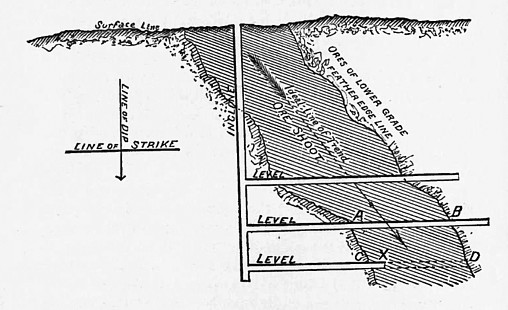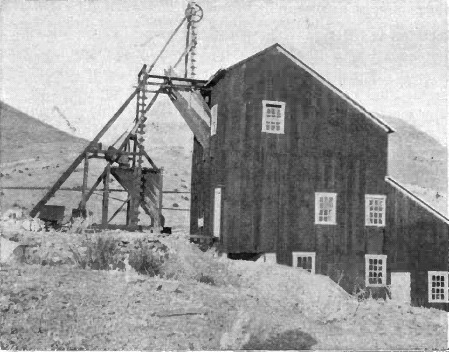THE FOLLOWING INFO IS
PRESENTED FOR ITS HISTORIC VALUE. PROCESSING WITH MERCURY IS NOT
RECOMMENDED.
Retorting and Percentage of Metal in Amalgam. The amalgam is retorted to
free the
gold from the mercury. This is accomplished in a closed
cast-iron vessel having a tube leading from it to carry away the volatilized
mercury and deliver it to a kettle re-condensed in liquid form. These
vessels are called retorts, and may be either large cylinders solidly set in
a foundation of brick over a fire-box, or they may be small portable affairs
that are placed over a fire made in a temporary furnace of brick or stone,
or even on the ground in the open air. The inside of the retort is lined
with three or four thicknesses of paper, with chalk, or with a paste of wood
ashes, lime, or red oxide of iron, to prevent the gold from sticking to the
sides. In the retort the balls of amalgam are placed so that it will not be
more than three-quarters full when the cover is placed on. If the 'sponge,'
as the metal after retorting is called, is to be shipped without being
melted into a bar, the amalgam is packed down tight to make a solid mass of
it, and a hole is forced down through the center to enable the mercury the
better to escape from within the mass. If the retorted metal is to be melted
into a brick before shipping, the balls are put in loosely since that will
allow the volatilized mercury to readily escape and the sponge to be easily
broken up for convenience in handling in the melting. A ring of lute made of
fire-clay, wood ashes, and a little salt is placed between the cover and
body of the retort to insure an airtight joint.
The retort is set in a furnace, on a tripod, or is carefully propped up in the open, and a slow wood fire started about it. This fire is gradually raised until the retort finally becomes cherry red; the heat being applied all about the retort, not on the bottom alone. The pipe coming out of the retort passes through an outer pipe, and in the space between them cold water is constantly circulating, which condenses the volatilized mercury to the liquid state. When using small retorts, gunnysacks wrapped about the pipe, to which cold water is continually applied, may successfully be used. A vessel filled with water is placed at the lower end of the pipe to catch the condensed mercury. A cloth should be wrapped about the end of the tube, forming an extension of it. This extension should dip beneath the surface of the water with which the pail is filled and which overflows as the mercury condenses. Care should be taken that the lower end of the pipe itself does not project into the water, as there is a tendency for the atmospheric pressure to force the water up into the pipe at times, due to the diminution of the volume of gas in the retort caused by the fire being checked or dying down; in such case the cloth will be drawn against the pipe and air drawn through the pores of the cloth, whereas, if the end of the pipe were in the water, the water might ascend into the retort and an explosion result. If the end of the pipe were exposed without the cloth, some volatilized mercury might escape if the condenser was not working properly, endangering salivation.
Retorting will take from 2% to 5 hours. The fire should be continued for 20 minutes after the mercury ceases to condense in the pipe as ascertained by tapping the pipe and watching for the mercury to drop out. When distillation is complete the fire is withdrawn and the retort allowed to cool. There is always danger of salivation if the retort is opened while hot. It is practically impossible to drive off the last of the mercury and it should not be attempted by raising the heat, as such heat may result in a partial fusion of the gold, causing it to stick to the retort, and is also destructive of the retort. Retorting with an assay furnace or on a blacksmith 's forge invariably results in using too high a heat. Where the amount of amalgam to be retorted is large, the oval or cylindrical retorts of large capacity before referred to are used in specially built furnaces. The amalgam is placed in cast-iron trays or separated by partitions of plate iron in these retorts, these trays or plates being well chalked or painted with ashes, lime, or other mixture and well dried to prevent the gold from sticking to them.
If the amalgam has been properly cleaned and retorted, the sponge will show a gold color and require a minimum amount of flux in the melting. Blackness indicates that the amalgam was poorly cleaned. A pale whitish color shows that it still contains mercury, and a bluish color generally indicates the presence of lead, usually babbitt. Retorting should be done in the open, or with the windows of the retort room open, to lessen the danger of being salivated, though there is little danger if proper precautions are taken.
The percentage of metal that is obtained from the amalgam by retorting and melting it into a bar depends upon the amount of impurities in the amalgam, and to a much greater extent on the size of the particles of gold. Coarse gold does not require as much mercury to amalgamate, or cement it, as a fine-grained gold. About 30 to 40% is the usual amount of bullion obtained from the amalgam of ordinary gold. With coarse gold as high as 65% of bullion has been obtained, while with an extremely fine gold the amalgam may run as low as 20% of bullion. This principle is true with respect to the point at which the gold is caught in the amalgamation process. The amalgam taken from the mortar-sand will retort the highest percentage of gold, since only coarse gold is caught there. The amalgam from the foot of the table will retort the lowest percentage of gold, as only very fine gold will reach that point before being caught. Harder squeezing in the canvas does not materially lessen the amount of mercury. The use of sodium amalgam will increase the amount of amalgam by amalgamating the fine iron, steel, and sulfide. In one case, with a fine gold that ordinarily retorted 22% bullion, sodium amalgam was used in starting new plates, resulting in an increased yield from these plates that assayed only 12% fine bullion.
Amalgam coming from battery stamps is often mixed with all sorts of rubbish. After being gathered, it is dried with a sponge, foreign matter picked off the surface and clean quicksilver added. Soft unglazed paper thrust into the mercury removes the last vestiges of water, and then a card is drawn vertically on a piece of blanket horizontally across the mercury to clean it of iron. After squeezing, the amalgam is retorted.
Continue on to:
Loss of Gold in Amalgamation and its Remedy by Mill Testing
Return To:
Hard Rock Quartz Mining and Milling


